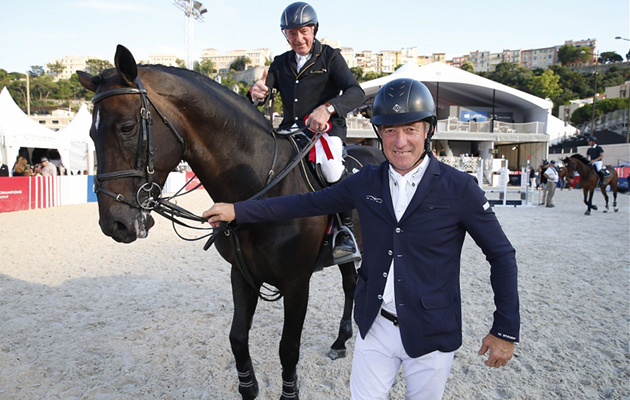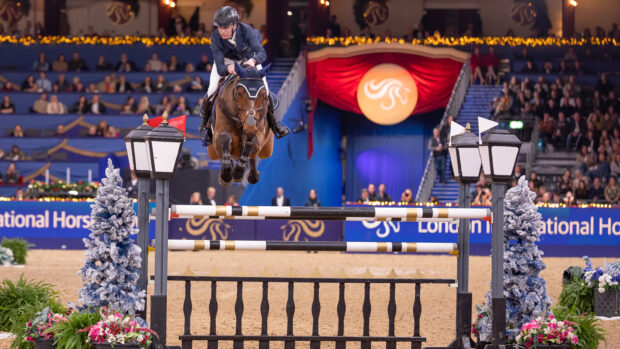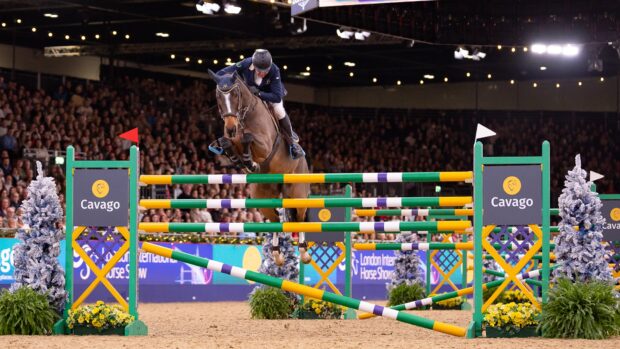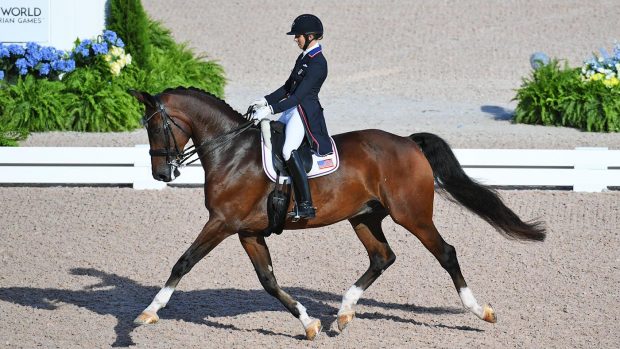John Whitaker’s floating wonder horse was the first showjumper to win over £1m. But his scintillating results tell only half the story of this charismatic showman, writes Jennifer Donald, as we celebrate Horse & Hound’s 140th anniversary in 2024
Every so often in our sport, a partnership captures the heart of a generation and earns a place in history. For nearly a decade, audiences were held spellbound by the magical aura of Milton and his rider John Whitaker. With the gelding’s sparkling white coat and breathtaking ability to float over the highest fences, Milton could rival Hollywood stars for his fans’ adoration; how fortunate that he thrived on the attention.
We revelled in the wonderful affair Milton had with John, who coaxed every ounce of brilliance from his willing wonder horse to triumph in back-to-back World Cups, claim over 30 major classes, six championship medals and become the first showjumper to win over £1m.
But the tale is tinged with tragedy as Milton’s original rider Caroline Bradley died before seeing her protégé reach the Olympic potential she had pinpointed in him.
Born in 1977 and originally named Marius Silver Jubilee, Milton was the result of a shrewd pairing conjured up by Oxfordshire breeder John Harding-Rolls, and had jumping blood pulsing through his veins.
His sire Marius was a big winner for Caroline, including the Queen Elizabeth II Cup, hence why she was drawn to pay £1,000 for the iron grey weanling. Caroline’s mother Doreen described the young Milton as “a funny-looking thing” and David Broome remembers it wasn’t all plain sailing for the future champion in the ring.
“He had a bit of a chequered career in those early days because he was so untidy in front,” he explains. “My assistant even saw him have 16 faults at one show.”
But Milton’s talent was clear to Caroline as she quietly produced him until she died suddenly of heart failure aged just 37 in the summer of 1983. Her parents originally offered John Whitaker the ride but he was en route to the Royal Highland Show and couldn’t commit to anything until his return two weeks later. Instead, they sent six year-old Milton with just £63 on his card to local rider Steve Hadley.
“By September he was jumping small grands prix and it was clear he was destined for great things,” Steve recalls. “It felt like he was on springs, he was beautifully balanced and he enjoyed it because he was good at it.
“At Park Farm’s Lancia Championships he jumped double clear in the £200 class each day and I said to my groom, ‘Look after that one because he’s the best you’ll ever see.’”
But misfortune struck ahead of his Olympia debut when Milton, whose one phobia was being clipped, lashed out.
“We don’t know if he hit the blade of the clippers or he struck himself, but he injured his tendon and had to have more than a year off, so he returned to the Bradleys,” says Steve.
An epic tale

John Whitaker and Milton in Aachen in 1991.
Paul Schockemöhle, who was instrumental in securing Next’s sponsorship of the Whitaker brothers and for whom Caroline rode several horses, wanted Milton for John as part of the deal.
“I was sad to lose Milton, but I’d decided to stop competing during that time anyway – he just arrived 10 years too late for me,” says Steve.
John takes up the epic tale: “I was at the World Cup Final in 1985 and Paul asked if I’d be interested in taking Milton on. I actually said, ‘I’m not really that bothered,’ but as a favour to Paul I said I’d try him.”
Even over their first cross-pole together, John knew he had “something very special”.
“He was light as a feather off the ground and I’d never experienced anything like it,” he says. “I rode up to the house, knocked on the window and said to [my wife] Clare, ‘Come and watch this horse jump!’”
John began eight-year-old Milton at some local shows then took him to Berlin, where he finished third in the small grand prix.
“A week later in Brussels he was second in the World Cup, then we went to Bordeaux and won the World Cup,” recalls John.
“It wasn’t all plain sailing. He had his own style coming off the ground in front at a fence – if you pushed him too deep or made him jump too quick he used to twist and he didn’t like it.
“He was nevertheless jumping a lot of clear rounds and we were picked for the Nations Cup at Hickstead in 1986, but Peter Robeson said in the collecting ring: ‘That horse needs a big ground line at the practice fence to help him get up in front.’ Once I figured out that was what he liked, we never looked back.”
The Bradleys gave John three stipulations: that Milton couldn’t do the Hickstead Derby; the Olympics, because of a previous dispute Caroline had with selectors; or the Suffolk Show, where she died, but the world soon took notice as the duo’s career went stratospheric.
The pair’s crowning achievement was winning double gold at the 1989 European Championships in Rotterdam, two years after securing individual silver and team gold.
“To win was a real milestone,” says John. “But to do it on Milton… He was a dream horse because he wanted to please you. After you’d jumped one fence he’d say, ‘All right, what’s next?’ He just loved the job and the more the crowd cheered, the higher he jumped.”
The following year, John and Milton scored their tremendous victory in the King George V Gold Cup at the Royal International – having been third in 1987 and second in 1988 and 1989 – before heading to the inaugural World Equestrian Games in Stockholm. Great Britain took bronze and John joined Eric Navet (Quito De Baussy), Hubert Bourdy (Morgat) and Greg Best riding the other famous grey, Gem Twist, for the horse-swap individual medal decider.
John, who finished with silver, remembers: “Gem Twist was a dream to ride, but he was the total opposite to Milton so when Greg rode Milton, it didn’t really work out and he had two fences down. But that woke Milton up, he wasn’t for knocking anything else down after that – and for about the next two months!”
Greg commented afterwards: “Getting to ride Milton was like finding out you’d got a date with the most beautiful girl in the world – you find yourself tripping over your feet.”
Among the other equine behemoths of the time were Pierre Durand’s Jappeloup and Ian Millar’s Big Ben, resulting in many thrilling showdowns with Milton, including during his astounding run of World Cup Finals. In 1989, Milton just missed out to Big Ben, but returned to take the title in 1990 and 1991 in Gothenburg, when the pair made the front page of the Swedish papers. They missed a potential hat-trick in 1992 when Milton was found to have pus in his foot, then the following year they finished runner-up to Ludger Beerbaum and Ratina Z.
“Milton was just as good indoors; he was a machine really,” says John affectionately.
The Bradleys’ Olympic stipulation had come to haunt John in 1988, possibly in Milton’s prime, when amid a media furore the pair couldn’t travel to Seoul. But Tom and Doreen had a change of heart in 1992, and John and a 15-year-old Milton joined the squad of Michael Whitaker, Tim Grubb and Nick Skelton in Barcelona, which would play out as one of the most heartbreaking conclusions to any medal-decider.
“He was maybe slightly past his best, but still very capable,” remembers John. “But I realised the really hard sand there was making his fetlocks sore when he jumped and he wasn’t enjoying it.”
Such was the horse’s class, however, they held the lead coming into the final round and expectations soared.
“He stumbled badly on landing in a massive combination so I pulled him out,” says John. “I was so disappointed because I had a fighting chance for a medal, but you can’t dwell on it.”
Greatest years

Milton’s machine-like quality also made him the mainstay of Britain’s all-conquering Nations Cup teams, at one point jumping seven consecutive double clears for his country from their regular number four spot. According to chef d’equipe Ronnie Massarella, Milton gave him “my greatest years in the sport”.
“One of Milton’s greatest assets was that every single day you knew what you’d get from him,” says John. “He was never looking for a way out – you just pointed him at the jumps and he’d do it. His floaty style over the jumps made it feel as though you were up in the air for ages – like you’d never come down, in fact!”
At home, Milton was a tremendous character and loved to be the centre of attention, kicking the stable door if the lorry left without him and becoming an adored member of the Whitaker family for 14 years.
“I used to race the kids on their ponies – I’d stagger Robert on his Shetland and Louise on her pony, all greys, down the field and say ‘Go!’ Milton loved that,” recalls John. “He loved the Shetland so much that we put him under Milton’s neck in the lorry if the kids took their ponies to shows. One Nations Cup, I was warming up for a crucial second round when the kids flew past on their ponies and all Milton would do is whinny at Robert’s Shetland.”
Milton would receive sack-loads of fan mail and the Whitakers tried to accommodate his many visitors. But he will always be remembered for his Lipizzaner-esque party piece that brought the crowd to its feet.
“He did it by accident the first time but I soon realised I could make him jump up off all fours to command,” reveals John. “I would canter round on the lap of honour, stop in middle and up he’d go.”
Vast popularity

Milton and John Whitaker at Olympia in 1989
Milton’s final competitions came in 1993, when John began to notice something niggling the 16-year-old. “I could have given him six months off to sort it, but I wanted such a brilliant horse to retire sound and healthy,” says John.
There was no way this megastar could slope quietly off to pasture though…
“Nearly every show in the world wanted me to do a retirement ceremony,” says John. “In Zurich, Tina Turner sang Simply The Best, then as the dry ice floated away, Milton and I were left standing in the ring with her. That was surreal. Of course, Milton lapped it all up.”
His vast popularity was evident in the many appearances he made in retirement. They joined Geoff Billington on a lecture demo tour; another time, John was joined by his brother Michael on another heroic grey, Desert Orchid.
“Milton loved showing off and it was good for him to have a purpose for another year or so,” says John.
After a couple of bouts of colic, Milton died in July 1999 at the age of 22 and is buried on John’s farm.
“I often give him a nod as I walk past,” John reveals. “Many people have asked, ‘Don’t you miss him, don’t you wish you still rode him?’ And I say, ‘Well at least I was lucky enough to have him.’”
Groom Penny Dalton on Milton
“Milton was 100% true character, and that made him the horse he was. He loved people, so if anyone didn’t pay him enough attention he would blow raspberries or grab your sleeve.
“But he could be the devil to look after. He didn’t like being rugged up – every morning he’d be standing with his rug over his head, or shredded on the floor, waiting to be rescued. He was a nightmare travelling, too – he was bored before you left Yorkshire and would paw constantly.
“People always wanted a bit of his mane and, before security was ramped up at shows, if I left my brushes out with white hair on them, they’d get taken.
“We were so upset when we lost him, but no other horse is remembered like Milton. Even people outside the sport knew him – being with Milton was like being with a pop star.
“At Modena, Pavarotti’s horse show, the great man himself wanted to meet Milton. Pavarotti was in tears just stroking Milton for ages, he was so in awe of this horse. It was a truly special moment.”
David Broome on Milton
“I first saw Milton at Newark Show. Caroline was riding him in the grade B&C class, and I asked how much she wanted for him.
“‘He’s not for sale,’ she replied. I said, ‘Never mind he’s not for sale, how much do you want for him?’
“She said no, she was keeping him, but eventually she promised that if she ever did sell him I’d have first chance, but then the poor girl died.
“Milton was very lucky to finish up with John because he brought out the best in him. I competed against Milton most of his life, but it was always nice to have him on our Nations Cups teams as last to go. Everyone who ever saw Milton jump was very privileged.”
Milton’s greatest achievements
- First showjumper to win more than £1m
- Winner of nearly 30 major grands prix, including the 1986 Du Maurier and 1990 King George
- Six championship medals – three gold, two silver, one bronze
- World Cup winner in 1990 and 1991
- Britain’s highest-earning horse from 1986 to 1991
Milton’s breeding
Milton was a real mix, by a Dutch warmblood stallion out of an Irish Draught/thoroughbred mare, with trakehner bloodlines on his paternal side and Anglo-Arab on his dam’s. Both sire and dam were grade A showjumpers – his dam was four when producing Milton, going on to compete with Derek Ricketts before being sold to Belgium as a broodmare, while his grand-dam Pennywort was the 1970 Foxhunter champion. Marius’s sire, Marco Polo, was a foundation sire of the modern Dutch warmblood sport horse.
You might also enjoy reading…

Senior Whitaker brothers land a win apiece: ‘Something I’ll remember for ever’

‘I’m 68, but I can still do it’: John and Michael Whitaker discuss longevity, mistaken identity and sibling rivalry

The Horse & Hound Podcast 141: John & Michael Whitaker
Horse & Hound magazine, out every Thursday, is packed with all the latest news and reports, as well as interviews, specials, nostalgia, vet and training advice. Find how you can enjoy the magazine delivered to your door every week, plus options to upgrade your subscription to access our online service that brings you breaking news and reports as well as other benefits.




